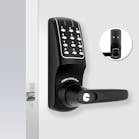The initial call came in late on a Friday. The facilities management company wanted us to adjust the exit device controlling the main entry to a building housing a retail bank branch as well as eight floors of tenant’s offices. I was familiar with the building, since we had installed a HID Solo on one of the offices last year; however, I had never worked on the main door.
The building had been totally renovated within the last ‘few’ years. The front door was apparently controlled by a card reader system supplied by a national security provider.
We sent one of our techs who was familiar with exit devices, and he soon realized the problem was beyond the scope of a service call.
Of course the functional problem was, simply stated, that the door was not operating properly with the card reader. The door was supposed to unlock automatically every morning, relock every evening, and allow access other times by means of an authorized credential (Proximity card).
The property manager was getting many complaints. The door was not unlocking in the morning; the door was found to be unlocked after hours; card holders weren’t able to gain access after hours.
Additionally, the schedule for the door was set for times outside of our normal hours. The door unlocked at 7 a.m. and relocked at 7 p.m. For us to be present to observe the door would involve additional overtime costs to the property manager, and he balked.
The facility manager did not understand that this door was actually a system composed of several sub-systems, and troubleshooting this type of system is best accomplished methodically.
I went to the site and surveyed the door. Immediately a few things were apparent. First this problem did not pop up overnight. I took a look around and asking some questions; after a few days for them to make enquiries, the following information was obtained. (Bear in mind that during this time, the door was not operating, and required them to manually dog the door every morning with a bungee, return every evening to remove the bungee, and the rest of the time, building occupants were arriving to the building, not gaining access, and frequently expressing their frustration by beating up the door)
• This was a large door hanging on a continuous hinge.
• The exit device was equipped with EL (Electric Latch) retraction.
• The bottom of the door had warped, preventing the bottom latch from seating properly.
• Both rods were not adjusted properly anyway.
The property manager did not know where the access controller was and did not know where the power supply for the exit device was. The property manager did not know how to program the locking schedule for the door.
The property manager requested I show up for a meeting with him and a representative from the national security provider. The rep for national security provider was clueless as to where the controller was, where the power supply was, and how to program the system. He apparently had some free time and so we all followed him around for a few hours as he poked around. The install had been done by others; there were no drawings or schematics, and another department at the national security provider handled programming the EAC.
After the meeting, we agreed that I would attempt to make some adjustments to the device. The device would not hold the adjustments I made, indicating some wear or damage to the device. The door was damaged and the bottom rod was not aligning, and when I hung a meter on the voltage going to the device, it was out of spec, indicating the device was not being powered by the proper power source.
The property manager was trying to save money. I told him we could perform a search and locate the power supply and controller, but we could not say how long it would take, or turning the page, if finding the power supply would actually cure the door given all the other issues. It would simply provide one piece of the puzzle.
Rather than allowing us to methodically troubleshoot the system, and rather than accept that there were major issues with the door itself, the client asked us to replace items in the exit device one at a time then see if that would do the trick. I recognized pretty quickly that doing the repair this way was going to run up the bill and probably not result in a happy ending, and asked my boss to intervene as a benevolent benefactor since the client was pretty much ignoring me.
It took about a month before the property manager finally got tired of the complaints from the end-user.
I have been dealing with old doors on banks for a long time, and realized that rather than dropping the door and either straightening it or replacing it ($$$); replacing the damaged the exit device (a discontinued model) and replacing and rewiring the special power supply specified for the exit device, a more cost effective solution would be to switch over to a electromagnetic lock solution.
The client finally said yes. We had the door converted in a day. The property manager reported that his phone stopped ringing as if by magic.
ELECTROMAGNETIC LOCK
I selected the LOCKNETICS 390+ for this door. The 390+ exceeds ANSI/BHMA A156.23 Grade 1 standards with 1650 pounds of direct holding force, is UL listed as an auxiliary lock for a three-hour fire-rated opening and for burglary resistance
The 390+ surface-mounted electromagnetic lock is ideal for high security applications. My first experience with the unit was when it was still offered by Security Engineering, and I have been installing them for several years
The 390’s modular design employs a standardized circuit board with easy-to-install connectors, adjustable mounting brackets, integrated mounting screws, and slide-in architectural finish plates. A new armature housing holds the armature in place, eliminating the noise and sagging known with armatures, increasing the overall reliability of the product.
The armature housing also provides an aesthetically pleasing look, blending into the surrounding environment. Finally the armature housing holds the magnets for the DSM option without having to mount an additional plate to the armature, ensuring quicker, more reliable installations.
The 390+ is available for single, inswinging or outswinging, hollow metal, aluminum, and wood doors and frames and glass doors. The 392+ is available for pairs of hollow metal, aluminum, and wood doors and frames and glass doors without a mullion. The 391+ with split armature is used with pairs of hollow metal, aluminum, and wood doors and frames without a mullion.
LOCKNETICS #672 TouchBar
The 672 TouchBar is a request-to-exit device which releases electromagnetic or electronic locks when the bar is depressed. It is designed for easy installation, smooth operation and maximum durability.
I selected the illuminated version of the product to add for improved visibility, safety and appearance of the opening.
The “Push to Exit” signage provides an obvious exit indication for building occupants and the simplified design allows for reversing the signage in the field. The new pivoting bar design allows 1/4” activation and the 2 1/4” low profile provides ample clearance through the door.
The device’s rugged cast ramped end caps deflect blows and provide extra durability. The 672 uses switches and mechanical movement to actuate, providing a reliable solution for egressing. The 672 is also available with a DPDT output, so you can switch both the electromagnetic lock as well as send a REX signal to your electronic access control System if required.
ESSEX PEBSSN1
ESSEX pushbuttons are highly reliable, and attractive. Using this pair of outputs, you can switch the lock and send a REX.
The bright LEDs are also configurable to indicate status of the locking device which is what I did on this project. The button responds to pressure rather than capacitance, and I’ve never gotten a complaint regarding sensitivity or operation.
SCHLAGE LOCKNETICS 510 POWER SUPPLY
The SCHLAGE LOCKNETICS 510 Series Power Supply is suitable for a wide range of applications, and I cannot recall one of them EVER failing on me. The output voltage is field selectable with an on board switch: 3amp @ 12 VDC and 2 amp @ 24 VDC.
The 510 is UL listed, filtered and regulated, has a built in battery charging circuit and is housed in a sturdy lockable metal enclosure.
The 510 Series is modular; adding further flexibility, ease and convenience to power electronic locking systems. For example, plug-in dual control modules can be added for independent control of up to six zones. Each dual control module (DCM) can provide control for two independent zones (six zones at 24VDC/300mA, or 12VDC/500mA).
Up to three dual control modules can fit into a control module rack (CMR). A plug-in adjustable relock time delay module (TDM) is available with a 0 to 30 second delay. It plugs into each zone of the dual control module to provide up to six TDM’s in each power supply.
We supplied the 510 with the emergency interface relay (EIR) module which plugs into the main circuit board to provides interface with approved fire or other emergency systems. A signal from the emergency systems automatically and instantly unlocks all locks connected to the power supply.
Altronix RB1224 Relay
This is one of my favorite problem solvers from Altronix. I always have these on hand because they’re so versatile. Relays are important for transitioning to provide isolation between different elements of the system where different voltages or grounds may exist.
The on-board red LED is quite helpful when troubleshooting, the 5 Amp contacts are usually more than adequate for most electric locking devices, and the field-selectable coil voltage cuts down inventory. This relay coil draws 75 mA. Altronix offers other relays with lower current draw, but as I say, the RB1224 is fine for most of my access control interfacing applications.
I like to mount them with plastic track rather than two-sided tape. It looks a lot neater and more professional.
I know the end-user will call right away if something goes wrong with this door, because due to his stubbornness and unwillingness to listen to reason, the final charges for all the service calls in addition to the maglock installation cost him plenty.
Tim O'Leary
Tim O'Leary is a security consultant, trainer and technician who has also been writing articles on all areas of locksmithing & physical security for many years.




